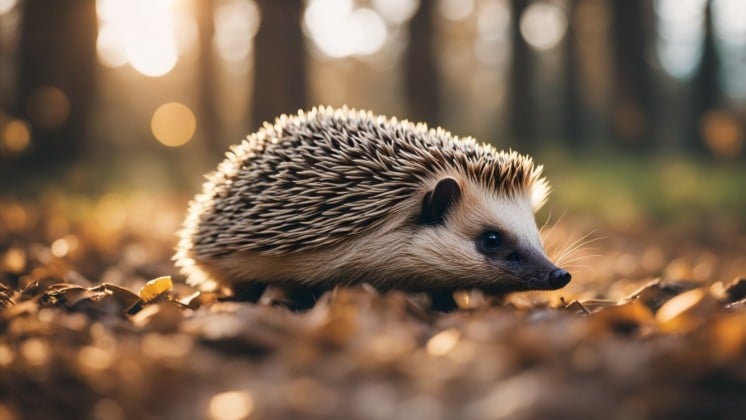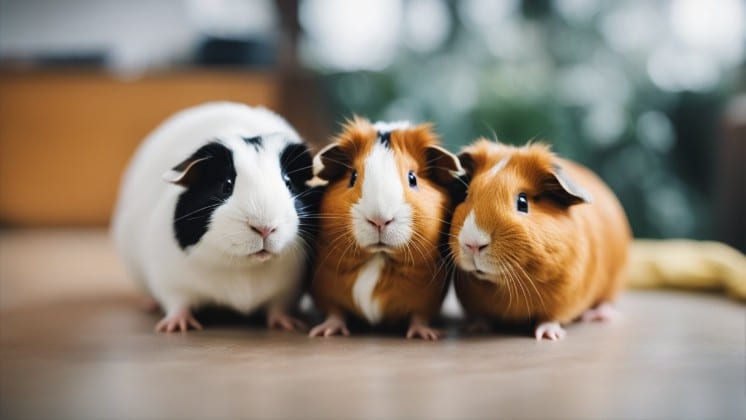Chinchillas are small, playful rodents known for their soft fur and unique personalities. While they are generally considered to be friendly and social animals, many owners wonder if these creatures are territorial or not, so are chinchillas territorial?
Chinchillas can be territorial animals, especially when it comes to their personal space and resources such as food, water, and toys. They may become aggressive towards other chinchillas if they feel their territory is being invaded or their resources are being threatened.
In this article, we’ll explore the question of whether chinchillas can be territorial and what this means for their care. We’ll also look at how to recognize signs that your pet may be feeling territorial in its environment.
Let’s begin!
Chinchilla’s territorial behavior
Chinchillas are not naturally territorial animals. In the wild, they live in large social groups and will actively seek out interaction with other chinchillas.
Aggression and its causes
Chinchillas are social animals, but, like all animals, they can display territorial behavior when they feel threatened or stressed.
This aggression can have various causes, such as a new or unfamiliar environment, competition for resources, or the introduction of new chinchillas.
To understand this behavior, we must keep in mind the natural habitat and instincts of chinchillas, which have evolved to protect their territory and resources.
Signs of territorial behavior
Territorial behavior in chinchillas can manifest in various ways, some of which are:
- Biting and scratching. Chinchillas may bite or scratch other chinchillas or even their owners when they feel threatened or territorial.
- Chasing and fighting. Chinchillas may chase and fight each other, particularly when a new chinchilla is introduced to an established group.
- Spraying urine. In some cases, chinchillas may spray urine on each other or their living space as a way to mark their territory.
Managing territorial behavior
To manage territorial behavior in chinchillas, we must create a calm and secure environment for them. Here are some practical suggestions:
- Provide enough space. Ensure that chinchillas have ample living space to prevent overcrowding and territorial disputes.
- Establish boundaries. Create separate areas for activities such as feeding, sleeping, and playing to minimize competition for resources.
- Introduce new chinchillas gradually. When introducing a new chinchilla to an existing group, do so slowly and with supervision to avoid sudden territorial disputes.
Chinchilla’s natural habitat
The habitat of these small mammals is important when it comes to understanding their behavior, so let’s dive a little deeper into their natural habitat.
Wild chinchilla Habitat
Chinchillas are native to the Andes Mountains in South America. They are primarily found in regions of Chile, Peru, Bolivia, and Argentina. In their natural habitat, chinchillas live at high altitudes, ranging from 9,800 to 16,400 feet.
They prefer rocky, mountainous terrain and are well-adapted to survival in extreme temperatures and harsh environments.
Their natural habitat typically consists of arid areas with a variety of shrubs and grasses for them to feed on. Wild chinchillas are known to seek shelter in crevices and rock pockets.
The location of their habitat influences their behavior, causing them to be a mostly nocturnal species.
They forage for food and water during the night, minimizing exposure to daytime predators and extreme temperatures.
Captivity vs. natural living
Chinchillas in captivity experience a much different environment than their wild counterparts. In captivity, we provide them with consistent shelter, food, and water, removing the need for them to forage or adapt to harsh elements.
This can lead to differences in behavior and overall well-being. Here are some key differences between the two:
| Captivity | Natural Living |
|---|---|
| Consistent shelter | Shelter in rock crevices |
| Constant food and water availability | Forage for food and water during the night |
| No predators | Presence of predators |
| Limited space | Expansive habitat |
While captivity can provide chinchillas with safety and convenience, it’s important to ensure their living conditions mimic aspects of their natural habitat.
Providing chinchillas with ample space, climbing opportunities, and hiding spots will help them maintain their instinctive behaviors and satisfy their territorial needs.
We must always remain conscious of the difference between captivity and natural living conditions for chinchillas to ensure the health and well-being of these fascinating creatures.
Read also: Do Chinchillas Get Along With Rats? What You Need to Know
Chinchilla’s social nature
Chinchillas are social animals that naturally live in groups called herds. In this section, we will discuss their interactions within the herd and with their owners.
Interaction within herd
In the wild, chinchillas form social groups or herds consisting of several individuals. They use these interactions to establish hierarchy, seek protection against predators, and share resources.
Within their social structure, chinchillas show a strong need for companionship and display social behaviors that help maintain cohesion among herd members.
There might be occasional disputes to establish dominance, but chinchillas usually coexist harmoniously.
However, it is crucial to monitor and manage any conflicts that arise among captive chinchillas to avoid injury or an escalation of aggression.
Interaction with owners
Chinchillas’ social nature also extends to their relationships with humans. They quickly adapt to living with their owners and develop close bonds when given time and attention.
It is essential for owners to handle and interact with their chinchillas regularly to establish trust and familiarity.
As chinchillas get comfortable with their owners, they tend to become more friendly and affectionate.
It is important to be patient and recognize that each chinchilla has its own personality and individual preferences for social interaction.
Caring for a chinchilla
Let’s be real; these pets require special care and attention. They aren’t just small rodents that you can throw in a corner and forget about.
Proper housing
When it comes to providing a comfortable and safe environment for chinchillas, the right cage setup is essential.
We recommend a spacious, well-ventilated cage with multiple levels for climbing and playing. The cage should have a solid floor to prevent foot injuries, and it should be filled with safe bedding such as aspen shavings or recycled paper products.
Providing our chinchillas with hiding spots, such as wooden boxes or PVC tubes, is essential for their comfort, as these pets often feel vulnerable in open spaces.
It’s also vital to include chewable toys made of chinchilla-safe materials since chinchillas need to wear down their ever-growing teeth.
Feeding and hygiene practices
A balanced and nutritious diet is crucial for maintaining our chinchillas’ health. We should provide them with high-quality chinchilla pellets and offer a constant supply of fresh hay, such as timothy or orchard grass.
Fresh water must be available daily, preferably in a water bottle with a sipper tube, to prevent contamination.
Chinchillas have unique hygiene needs, which include regular dust baths to keep their fur in optimal condition.
We should provide a dust bath container filled with specially formulated chinchilla dust at least twice a week. Chinchillas will roll around in the dust, allowing them to absorb oils and dirt from their fur.
Our chinchillas’ cages should be cleaned regularly to maintain a healthy environment. Waste and soiled bedding should be removed daily, while a full cleaning, including changing the bedding and disinfecting the cage, should be done at least once a week.
This will help keep our pets healthy and prevent potential health issues caused by poor hygiene.
Chinchilla’s mating and breeding
Chinchillas are small rodents native to South America, commonly found in the mountain regions.
This section discusses their mating and breeding habits, focusing on gender-specific behaviors and the breeding season.
Gender-specific behavior
Male and female chinchillas exhibit different behaviors during the mating process. Male chinchillas are known to be more aggressive and territorial compared to females.
They may mark their territory using scent glands located on their rear and fight with other males to protect their space or gain access to females.
Females, on the other hand, tend to be more passive and less territorial. They rely on body language and vocal communication to express their readiness to mate.
Once a female chinchilla becomes receptive, she may display submissive behaviors, such as lifting her tail or flattening her body, to signal her interest in mating.
Breeding season behaviour
Chinchillas have a breeding season that typically lasts from November to May in their natural habitat.
Peak breeding activity occurs during this time, with females usually receptive to mating every 30 to 40 days. Their reproductive rate slows down during the colder months of June to October, with most females unlikely to be receptive during this time.
During the breeding season, chinchillas may alter their behaviors to increase their chances of successful reproduction.
Males will become more active and aggressive in seeking out potential mates, especially those that are receptive. This heightened activity and aggression can also extend to their interactions with other males, leading to skirmishes and fights over females and territory.
Females will show increased receptivity during the breeding season. They are more likely to display the submissive behaviors mentioned earlier, signaling their interest in mating.
Also, some females may increase their use of vocalizations to attract males or to communicate their readiness to mate.
Chinchillas exhibit distinctive mating behaviors depending on their gender and the time of year.
Males are generally more territorial and aggressive, while females express their interest in mating through submissive displays and increased vocalizations.
The chinchilla’s reproductive activities are heavily influenced by the breeding season, with the majority of mating and breeding taking place between November and May.
Read also: Hedgehogs and Chinchillas: Do They Get Along? (Explained)
Understanding chinchilla’s anatomy and physiology
To further understand chinchilla behavior and their territorial nature, it is important to consider their anatomy and physiology.
Physical attributes
Chinchillas are small mammals belonging to the Rodentia order. Their anatomical features play a crucial role in their territorial behavior.
Chinchillas have dense, soft fur that provides insulation against cold temperatures. The fur also serves as a protective layer against predators, allowing them to camouflage in their natural habitat.
Their long, bushy tails help them maintain balance when navigating through rocky terrains. Chinchillas have powerful hind legs that enable them to jump and leap with agility. This aids in escaping predators and securing good spots in their territory.
Sensory capabilities
In addition to their physical attributes, chinchillas have unique sensory capabilities that contribute to their territorial behavior.
These nocturnal animals have large eyes that provide them with excellent low-light vision. Their sense of hearing is highly developed, allowing them to detect even the faintest sounds.
Chinchillas also have scent glands on their abdomens that contribute to their territorial nature.
These glands secrete an oil that marks their territories. By rubbing their scent glands against rocks, logs, or other surfaces, chinchillas establish their presence and discourage other members of their species from entering their territory.
In conclusion, understanding chinchillas’ anatomy and physiology is essential to better comprehend their territorial behavior.
Both their physical features and sensory capabilities are critical factors that influence their interactions and relations with other chinchillas in their habitat.
Summary
- Chinchillas can be territorial animals, especially when it comes to their personal space and resources such as food, water, and toys.
- They may become aggressive towards other chinchillas if they feel their territory is being invaded or their resources are being threatened.
- To manage territorial behavior in chinchillas, we must create a calm and secure environment for them.
- Chinchillas are social animals that naturally live in groups called herds.
- Providing chinchillas with ample space, climbing opportunities, and hiding spots will help them maintain their instinctive behaviors and satisfy their territorial needs.
- Understanding chinchillas’ anatomy and physiology is essential to better comprehend their territorial behavior.
Final thoughts
That’s it!
We’ve concluded that chinchillas are territorial animals due to their physical attributes and sensory capabilities.
Moreover, the breeding season is a period when males become more active and aggressive in seeking out potential mates, while females display submissive behaviors and increased vocalizations to attract males.
We hope you found this insightful and useful in understanding the territorial nature of chinchillas.
Want to learn more about chinchillas?
Ready to boost your knowledge to the next level? If so, check out the articles below:





